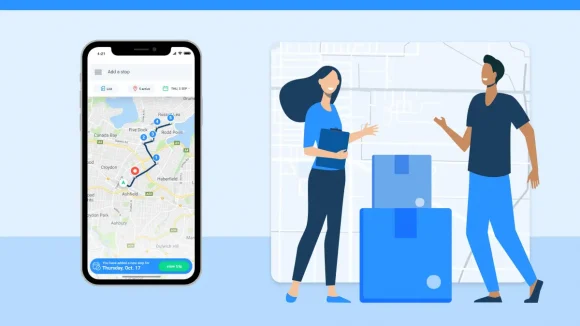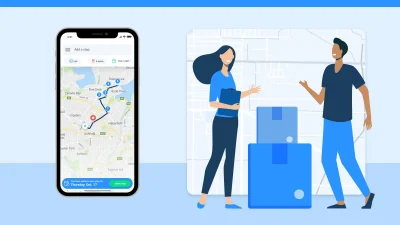Efficient route planning is crucial for businesses and individuals looking to optimize their travel time, minimize costs, and enhance productivity. Whether you’re a delivery driver, a field service technician, or simply planning a road trip, strategic route planning can make a significant difference in your overall experience. In this article, we will explore 5 essential tips for efficient route planning, including the use of GPS and mapping tools, considering traffic patterns and peak hours, optimizing for distance and time, planning for multiple stops, and regularly updating and adapting routes. By following these tips, you can streamline your journeys, save time and resources, and enjoy a smoother and more efficient travel experience.
5 Essential Tips for Efficient Route Planning
Let’s get into the 5 essential tips for efficient route planning!
I. Make Use of GPS and Mapping Software
GPS and mapping software has transformed the way we navigate and plan our routes. With technological improvements, these tools have become vital resources for efficient route planning. Using GPS and mapping apps when driving, walking, or cycling can dramatically improve your trip experience.
Google Maps is one of the most popular GPS and mapping software. It provides detailed mapping data and a variety of functions to aid users in effectively reaching their locations. Turn-by-turn directions, real-time traffic updates, and alternative routes depending on current road conditions are all available on Google Maps. The program also estimates arrival times, allowing users to plan their trips accordingly. Google Maps has gained popularity due to its user-friendly interface and intuitive design.
Aside from these well-known programs, there is specialized route planning software available for organizations and professionals who want additional capabilities suited to their requirements. These programs provide complete route optimization functionality, allowing customers to schedule several stops, improve delivery routes, and reduce travel time. They frequently examine things like traffic patterns, vehicle constraints, and delivery windows while designing the most effective routes. For firms that rely on transportation and logistics, route planning software can greatly boost efficiency and cost-effectiveness.
Using GPS and mapping technologies not only aids in the discovery of the best routes but also enhances overall safety. These apps help drivers avoid congested regions and potential hazards by offering real-time traffic updates and alternate routes. This results in a smoother and more efficient travel experience while reducing the risk of accidents or delays.

II. Think about traffic patterns and peak hours.
Traffic patterns and peak hours must be addressed while designing an efficient route. Understanding local traffic patterns and peak times of day may assist you in avoiding unnecessary delays and stress on the road. You can save time and make better use of your resources by incorporating this information into your route planning.
To begin, become acquainted with the typical traffic patterns in your area. Pay close attention to major roads, intersections, and highways at various times of the day. Keep track of which routes are frequently crowded and when they are at their worst.
There are several traffic apps and websites accessible to acquire real-time traffic information. These tools provide up-to-date information on traffic congestion, accidents, and other road incidents. Popular programs like Google Maps, Waze, and dedicated traffic monitoring websites can supply you with vital traffic information. They usually use data from GPS signals, crowd-sourced information, and official traffic reports to provide precise and dependable updates.
When planning your journeys, keep in mind the peak hours in your area. These are the times of day when traffic is usually the worst due to rush hour or other factors like school or event traffic. You can reduce your chances of being stuck in traffic and save money by avoiding these peak hours.
During peak hours, consider using less congested alternative routes or backroads. GPS and mapping software routinely recommend other routes based on current traffic conditions. These routes may be longer, but they will save you time by avoiding congested areas. If you are open to alternative routes, you can make greater use of the available road network and identify less-traveled paths to your goal.
It should be noted that traffic patterns vary according to the day of the week, holidays, and special events. Be mindful of any exceptional situations, such as sporting events, concerts, or construction zones, that may influence traffic flow. Keep track of any temporary road closures or detours that may cause your planned routes to deviate.
III. Adjust for Distance and Time
Optimizing routes for both distance and time is critical for making the most of your trip plans. You may determine the most efficient routes that strike a compromise between decreasing distance traveled and optimizing time efficiency by taking into account numerous variables such as distance, projected traffic conditions, and speed limitations.
Using algorithms or specialist route planning software is one technique to optimize routes. To calculate the most effective routes, these programs consider criteria such as road distance, projected trip time, traffic patterns, and speed limits. They examine several routes and choose the one that minimizes both distance and travel time. These algorithms can perform complex computations and take into account real-time traffic adjustments to deliver accurate and up-to-date information.
You can lower the overall distance traveled by using these tools, which have various advantages. For starters, shortening the distance can assist reduce fuel usage, especially on long travels or routes with several stops. By picking the quickest route, you can save money and environmental resources by reducing unnecessary travel and optimizing fuel efficiency.
Additionally, optimizing for time efficiency is critical. You can make better use of your existing resources and boost productivity by selecting routes that minimize trip time. Time optimization can contribute to faster order fulfillment and higher customer satisfaction for firms that rely on transportation or delivery services. Individuals can also profit from reduced commute time, which allows them to devote more time to other activities or complete more chores throughout the day.
It is critical to examine various variables that may affect travel efficiency while planning routes for distance and time. Road conditions, road closures or diversions, traffic lights, and speed limits are examples of variables. By incorporating this information into the route planning process, you can ensure that the routes you choose are realistic and in line with the current road situation.

IV. Make Provisions for Multiple Stops and Sequential Ordering
When you have many stops on your journey, intelligent route planning becomes even more crucial to ensure efficiency. You can save travel time and distance, streamline your route, and make better use of your resources by carefully evaluating the sequence in which you visit each destination. This includes parameters such as stop proximity, delivery time windows, and any client requests.
Begin by gathering all of the relevant information about your various stops. Determine the addresses of each place and make a note of any special requirements or time limits. Determine the time slots in which you must arrive at each stop, taking into account any client preferences or deadlines. Knowing the restrictions and expectations for each stop can help you plan your journey more successfully.
Once you’ve acquired all of the data, you may start improving the stop sequence. The idea is to reduce travel time and distance by organizing the stops in such a way that the route flows smoothly. Consider the proximity of the stops and arrange them together with those that are geographically close. By visiting nearby stops consecutively, you can avoid unnecessary backtracking and reduce overall travel time.
Once you’ve acquired all of the data, you may start improving the stop sequence. The idea is to reduce travel time and distance by organizing the stops in such a way that the route flows smoothly. Consider the proximity of the stops and arrange them together.
Consider the time windows for deliveries or appointments as well. Arrange your stops so that you may meet these time constraints as efficiently as possible. This ensures that you can supply goods or services within the time constraints specified while maintaining client satisfaction. Planning your itinerary following time constraints will help you avoid delays and any conflicts between stops.
It is critical to be aware of any potential bottlenecks or traffic patterns that may affect your trip. Take into account traffic conditions, road closures, and any other circumstances that could cause delays or influence the best order of your stops. Use real-time traffic data from GPS and mapping apps to adapt your route if necessary, especially if unexpected changes occur during your drive.
Once you’ve acquired all of the data, you may start improving the stop sequence. The idea is to reduce travel time and distance by organizing the stops in such a way that the route flows smoothly. Consider the proximity of the stops and arrange them together.
While optimizing the sequence of stops, keep in mind other aspects such as your vehicle’s capacity and any special needs related to the stops. If you are hauling perishable items, for example, you may need to prioritize stops that are closer together or require rapid care. By considering these criteria, you may assure efficient resource usage and successful journey planning.

V. Update and adapt routes regularly
Updating and adjusting routes regularly is crucial to preserving efficiency in your travel plans. You may make informed decisions and change your routes by staying updated about changing circumstances and employing real-time data. This adaptability ensures that you can deal with unexpected situations and improve your vacation.
Real-time traffic information is one of the most important sources of information for route changes. Live traffic updates are frequently provided by GPS applications and mapping tools, indicating congested regions, accidents, or road closures. You can proactively alter your route to avoid traffic bottlenecks or barriers by periodically checking these updates. By doing this, delays are reduced and travel is made easier.
Keep track of any road closures, construction, or other things that may affect your trip in addition to traffic updates. To stay informed, check local transportation authorities’ notifications or updates, or use traffic information websites. Knowing about these changes enables you to prepare for other routes or make required modifications while driving.
You can modify your route in real-time using options that are available in GPS programs and mapping software. You may make prompt decisions to maximize your trip efficiency thanks to real-time traffic information, rerouting possibilities, and dynamic recalculation of directions. By making use of these capabilities, you can prevent unforeseen traffic jams, collisions, and other road mishaps that might alter your intended itinerary.
When it comes to changing routes, flexibility is essential. During your trip, unanticipated things or circumstances can alter, like customer demands, delivery schedule modifications, or last-minute appointments. It’s crucial to be ready to change your route to account for these adjustments. Consider alternate routes or use route-planning software that enables simple re-optimization in response to fresh facts. This flexibility guarantees that you can fulfill customer requirements, meet deadlines, and make the most efficient use of your time and resources.
5 Essential Tips for Efficient Route Planning: Conclusion
A crucial skill that can result in considerable time, money, and productivity gains is efficient route planning. You can streamline your routes and increase the effectiveness of your transportation or travel efforts by adhering to the five crucial suggestions presented in this article. Take advantage of technology, be aware of traffic patterns, plan your route with several stops in mind, optimize for distance and time, and update and modify it frequently. By putting these tactics into practice, you’ll not only increase your productivity but also make traveling easier and more seamless. Start using these suggestions right away to discover the transformational potential of effective route planning.
What is route optimization software?
To plan and optimize their routes for optimal efficiency, organizations and individuals can use route optimization software. It uses algorithms and sophisticated algorithms to determine the best routes depending on a variety of variables, including distance, traffic, time limitations, and delivery priority.
The ultimate route planner app: Locate2u
Now that we’ve gone over the 5 essential tips for efficient route planning, let’s get into the ultimate route planner app!
Efficient route planning and optimization are vital for successful delivery operations and effective delivery management. By utilizing route optimization software and advanced planning techniques, businesses can optimize their delivery routes, minimize travel time and distance, and enhance overall operational efficiency. Tools like Locate2u, a delivery route planning software, offer features specifically designed to optimize delivery routes and streamline delivery operations.
With the help of route optimization software, businesses can plan and optimize delivery routes by considering factors such as distance, traffic conditions, time windows, and customer preferences. By strategically arranging the sequence of stops and making real-time adjustments based on traffic updates, businesses can ensure the most efficient delivery routes. This not only reduces fuel consumption and transportation costs but also allows delivery drivers to complete their routes promptly, improving customer satisfaction.
Efficient delivery routes also contribute to consistent customer communication. With optimized routes, businesses can provide accurate delivery estimates to customers and maintain transparency throughout the delivery process. This helps build trust and ensures that customers are well informed about the status of their deliveries.
By optimizing delivery routes and using route planning software, businesses can streamline their delivery operations and overcome challenges such as traffic congestion, road closures, and changing customer requirements. This level of adaptability and flexibility allows businesses to make informed decisions, adjust routes as needed, and optimize delivery time.
Overall, incorporating route planning and optimization into delivery operations is crucial for businesses to achieve efficiency, reduce costs, and provide excellent customer service. Tools like Locate2u provide businesses with the necessary features to plan, optimize, and manage their delivery routes effectively. By leveraging such software and implementing best practices in route planning and optimization, businesses can ensure the most efficient delivery routes, improve operational performance and achieve greater customer satisfaction.
Start optimizing your delivery routes with Locate2u today!
About the author
Marketing Coordinator at Locate2u having completed a Bachelor of Creative Arts, majoring in English Literature and Creative Writing. I have extensive experience in editing and proofreading, as well as creating content for a range of audiences.











